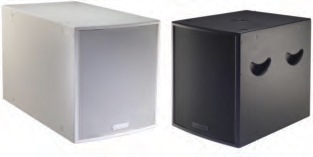Expanding Subwoofer Options Require Strategic Placement
Community VLF115 and VLF118 Subs.'Power alley' may sound like an ’80s Nintendo racing game, but for modern commercial installers, working around it is a real challenge with no option for a replay. Clients are demanding better quality, full-bandwidth sound in commercial installations, and manufacturers have answered the call by expanding product lines with in-ceiling or surface-mounted subwoofers. These powerhouses are able to reproduce the lower frequencies that full-range loudspeakers cannot handle, but may leave an installer wondering how many low-frequency devices to use—and how to place them.
We went right to the source and asked manufacturers to share their tips for effective subwoofer placement in commercial installations.
“A question that is frequently asked is, ‘Where and how many lowfrequency devices should be used?’ While many factors influence the answer, questions need to be addressed such as speaker sensitivity, ambient SPL, and required SPL at the listeners’ ears. Generally, placing an in-ceiling or surface-mount loudspeaker against a wall adds in about 3dB of ‘free’ low-frequency energy. Placing the same speaker also near the ceiling adds
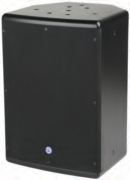
Atlas Sound’s
SM8SUB70-B Surface Mount
Subwoofer.an additional 3dB, and placing the same speaker in a corner near the ceiling yields another 3dB gain. This is called ‘corner loading’ and is recommended for subwoofer installation whenever possible. A ratio of one subwoofer to every four full-range loudspeakers is recommended to achieve ‘good’ low-frequency reproduction.”
—Dan Murphy, Senior Vice President, Atlas Sound
“Because they produce very long acoustic wavelengths, subwoofers interact strongly with the room and with each other. To avoid exciting multiple room modes, try to keep single subs (or subwoofer stacks) away from symmetrical locations like the center of the stage. Dual subs (or dual stacks) placed symmetrically at stage left and right can create a ‘power alley’ with excessive bass in the audience center and a drop-off at the edges. It may be better to use a single, larger sub in small- to mid-sized rooms and place it off-center. In larger rooms, distribute several subs across the stage using DSP level and delay to control the pattern. Flown systems may need additional subs because they lack the benefit of a floor reflection. When the subs are distant from the mains, you may experience a smeared or moving stereo image. To avoid this problem, use a lower crossover frequency and add mid-bass loudspeakers to the mains. Always try to avoid mechanical vibrations from building structure (ceiling or wall panels, stage structure, etc.). When placing subwoofers under a stage, build a heavy-walled chamber and stuff the space around the subwoofer with fire-proof insulation.”
—John Loufik, Senior Application Engineer, Community Professional Loudspeakers
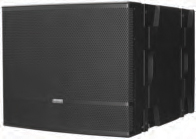
EAW’s NTS250 is a self-powered (dual channel) subwoofer system in an enclosure designed to fly above an NTL720 line array.“If consistent tonal balance across an audience large area is a goal, designers should consider suspending their subwoofers in a central location to try to equalize the loudspeaker-listener distance for all seats and minimize ‘power alleying’. Other times off-axis attenuation may be the primary concern (perhaps for feedback rejection or because the space is reverberant), suggesting a directional array as the best choice—delay-arc, cardioid, or hyper-cardioid, in the most basic forms. More often than not however, physical form factor and available space are the driving forces behind the selection and placement of a subwoofer, and this can sometimes even override acoustical considerations. The aforementioned strategies are not mutually exclusive; they can be combined in a number of ways (i.e. flown cardioid arrays or ground-stack delay arcs), and the EAW Application Support Group often recommends these types of ‘hybrid’ solutions to customers in order to provide the best balance of performance and practicality. In almost all cases, the benefit of modeling in advance of installation cannot be stressed enough.”
—Adam Shulman, Installed Systems Support Manager, Application Support Group, EAW
“Placing the subwoofers within a short distance of the main arrays will provide better summation across the entire audience area. The proximity of the mains and subwoofers will also provide better coherency for the entire audience, resulting in increased impact and more uniform tonal response. Ideally, don’t exceed 1/3 to 1/2 a wavelength from mains to subs, the formula being 1125” over
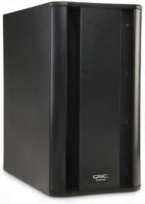
QSC K Series 2x 12in 1000w Powered
Subwoofer.‘Frequency*2’ for 1/2 wavelength spacing, or 1125” over ‘Frequency*3’ for 1/3 wavelength, or approximately six to nine feet for a 60 Hz crossover.”
—Scott Sugden, Head of Application, Touring, L-Acoustics U.S.
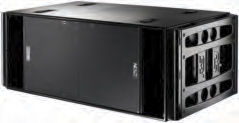
Yamaha’s NEXO RS18.“When installing recessed in-ceiling mounted subwoofers into a foreground distributed music system, placing the subwoofer in the center of the coverage pattern and allowing one subwoofer for every two full-range loudspeakers will yield best results. For surface mounted subwoofers, deployment in a corner or eighth space setting will improve subwoofer performance as the sub will benefit from the pi/2 loading from the three surfaces. In both cases—whether it’s an in-ceiling or a surface mount subwoofer—driving the sub at low impedance is advised. Lesser quality 70/100v transformers in subwoofers can quickly saturate, leading to the degradation of acoustic performance.”
—Travis Nie, Systems Application Engineer, QSC
“The biggest thing I can recommend is have a plan, but also plan to have time to do some experimenting if at all possible before you are locked into your final sub placements. For indoor installations, the performance of the subwoofer system is dependent on their placement relative to each other, relative to the main system, and their interaction with the room; walls, ceilings, and other barriers nearby can affect the final results. If you find you have some problems with the sub coverage, it might be solved by moving the subwoofers or adjusting their timing relative to the main system and/or each other. Take the time to listen and don’t be afraid to try a different placement or delay timing to see if it might improve performance. Just don’t forget to check the whole room again after making changes to make sure the fix did not affect performance somewhere else.”
—Joe Rimstidt, Systems Design Engineer, Yamaha Commercial Audio Systems
Derek Dellinger is the online editor for SCN and Residential Systems.
